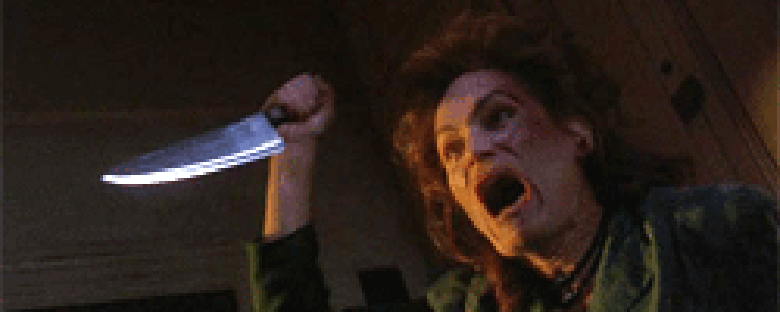Reviews
Wes Craven
USA, 1991
Credits
Review by Adam Balz
Posted on 07 October 2006
Source Universal Pictures DVD
Related articles
Features: 31 Days of Horror
Wes Craven holds an interesting place in the progression of horror cinema. Having begun his career with The Last House on the Left and The Hills Have Eyes, two raw, grueling depictions of social isolation and revenge, he gained a new following twenty years later with the genre-deprecating Scream series. With Freddy Krueger he created one of horror’s most recognized villains, the unremitting scourge of sexually active teens, their skeptical parents, and Zsa Zsa Gabor; but by the seventh installment, even Craven admitted to having lost track of the storyline, and Krueger became a caricature of himself, exemplified by the casting of Alice Cooper as his father in Part VI. Craven’s Red Eye, a safe departure from expectations, was nothing if not overbearingly commercial, while Music of the Heart marks a short, gentle divergence in his career. Caught in the middle is his The People Under the Stairs, an attempt at balancing genre norms with blatant social commentary and the fairytales of childhood.
Poindexter (nicknamed “Fool”) is the good boy growing up in a bad world—in this case, a Los Angeles ghetto. Surrounded by addicts, dealers, and pimps, Fool barely makes due with his trick-turning sister and ill mother. When they’re evicted by their landlords– the same couple, we later discover, who’s bought and evicted much of the ghetto– a plan is implemented to break into their home and steal rumored gold coins. But the plan goes awry. The couple is sadistic; their home has been renovated into a fortified labyrinth of traps, torture chambers, and prison cells. The Man, referred to regularly as “Daddy,” frequently dresses in BDSM drag and delights in dissecting, tasting, and feeding the organs of intruders to his caged and mutilated children; the Woman, “Mommy,” is a domineering psychopath whose hold over Alice, their daughter, also extends to Daddy.
While The People Under the Stairs prides itself on being disturbing and claustrophobic, it’s not sound in its attempts at seriousness. This is a story of desperation in the ghetto, of finding yourself abandoned by society; the topics of incest, abuse, rape, cannibalism and torture, of racism and greed and a sourceless homicidal mentality, should be treated with a careful discrimination if they’re to be shocking. Where Craven’s previous forays into humor, most notably with the Nightmare series, meshed nicely with the film’s flow, the jesting herein is incongruous. Craven, we realize, must have a purpose for such incompatible frames of mind. As I watched the film, my first viewing in well over ten years, I was struck by how crude and undeveloped the story was. Thirty minutes in I finally discovered why: Craven’s film is, in essence, an R-rated children’s movie.
The Disneyesque themes are ubiquitous. The character of Fool is pure, untouched by the forsaken atmosphere of ghettos; as we learn in the beginning, he wants to be a doctor, a fact that amuses those around him. When Fool first meets Alice, he introduces himself and shakes her hand, then promises to help her escape. The final scene, which solidifies both Fool’s good nature and the good nature of those in his impoverished neighborhood (and, years ago, my admiration of actor Bill Cobbs), is a prime example of the broken and castigated coming together in a diplomatic and highly idealistic manner. And while the underlying observations on race become lengthy and tiring, they do convey an important theme: the power of community transcending all barriers. At the same time Fool’s community rallies against their tormentors, Fool and Alice help to free those locked in the basement. The people under the stairs, as they’re known, have formed their own collective identity; they work together to survive, and to save Fool from the Man.
Everett McGill and Wendy Robie, who portrayed spouses in David Lynch’s Twin Peaks, are unbelievably chilling as Mommy and Daddy. When we initially think of them as a married couple, they’re portraits of madness in matrimony; when we later learn of their true bond as brother and sister, their union becomes even more unsettling. Attempting to fully understand their relationship is both an arduous and undesirable task; they seem to be separate entities at certain times, while other moments have them disquietingly close. They are brother and sister, husband and wife, mother and son; Daddy’s seeming sexual attraction to Alice is sick, especially since we never see the manner of punishment he inflicts on her, and Mommy’s recording of her leading Daddy in bedtime prayer is terrifying.
The tagline for Wes Craven’s The People Under the Stairs says, “In every neighborhood there is one house that adults whisper about and children cross the street to avoid.” While this may be true of some cinema neighborhoods–worn and imbalanced shutters, an overgrown lawn, featureless eyes seeming to peer out from behind latticed curtains–the idea of a home sheltering something feared yet unseen, wholly wicked yet dubious in fact, has grown from the storylines of horror films into a ridiculous and banal convention now found more often than not in family films. This year saw the release of Sony Picture’s Monster House, while the last decade has brought us similar plots in The Haunted Mansion and Casper, among others. (More proof of this can be seen in The Paper Brigade, a blissful Disney film in which horror icon Robert Englund portrays the crazy-yet-misunderstood neighbor.) Obviously the transition from mainline horror to silly marketability wasn’t spontaneous–it took, ironically enough, Wes Craven.
We don’t do comments anymore, but you may contact us here or find us on Twitter or Facebook.



